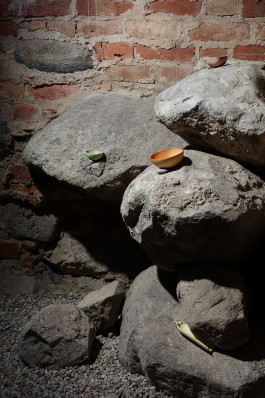

Exhibition: Bruch (2025), Historischer Keller, municipal gallery, Berlin | Images: CHROMA
Work: Kin (Schalen), porcelain clay, spray paint
DE
Früchte und Gemüse, in der Malerei häufig Sinnbilder von Fülle und Vergänglichkeit, erscheinen hier nur noch als leere Hüllen. Durch das Abformen ihrer Oberfläche und die nahezu hyperrealistische Bemalung wirken sie für einen Moment real – doch ihre Substanz fehlt. Was bleibt, ist die Spur, das Echo einer verlorenen Präsenz. Diese Leere wird zum materiellen Zeugnis vergangener Fülle und zum Sinnbild globaler Erschöpfung. Sie verweist über das Objekt hinaus: auf ausgelaugte Böden, unsichtbare Arbeit und koloniale Verflechtungen, die den meisten Konsumprodukten innewohnen. Zwischen sinnlicher Erfahrung und kritischer Reflexion verwandelt sich die delikate Skulptur in ein Bild des Verschwindens. Im Sinne eines Symbiozäns (Glenn Albrecht) – einer möglichen Zukunft, in der Mensch und Natur in wechselseitiger Verbundenheit existieren – wird die Spur zur Botschaft einer notwendigen Umkehr.
EN
Fruits and vegetables, long regarded in painting as symbols of abundance and transience, appear here only as empty shells. Through the casting of their surfaces and the almost hyperrealistic painting, they seem real for a brief moment—yet their substance is missing. What remains is the trace, the echo of a lost presence. This emptiness becomes a material testimony to past abundance and a metaphor for global exhaustion. It points beyond the object itself—to depleted soils, invisible labor, and colonial entanglements inherent in most consumer goods. Between sensory experience and critical reflection, the delicate sculpture transforms into an image of disappearance. In the sense of a Symbiocene (Glenn Albrecht)—a possible future in which humans and nature exist in reciprocal connectedness—the trace becomes a message of necessary reversal.


Exhibition: Bruch (2025), Historischer Keller, municipal gallery, Berlin | Images: CHROMA
Work: Kin (Schalen), porcelain clay, spray paint
DE
Früchte und Gemüse, in der Malerei häufig Sinnbilder von Fülle und Vergänglichkeit, erscheinen hier nur noch als leere Hüllen. Durch das Abformen ihrer Oberfläche und die nahezu hyperrealistische Bemalung wirken sie für einen Moment real – doch ihre Substanz fehlt. Was bleibt, ist die Spur, das Echo einer verlorenen Präsenz. Diese Leere wird zum materiellen Zeugnis vergangener Fülle und zum Sinnbild globaler Erschöpfung. Sie verweist über das Objekt hinaus: auf ausgelaugte Böden, unsichtbare Arbeit und koloniale Verflechtungen, die den meisten Konsumprodukten innewohnen. Zwischen sinnlicher Erfahrung und kritischer Reflexion verwandelt sich die delikate Skulptur in ein Bild des Verschwindens. Im Sinne eines Symbiozäns (Glenn Albrecht) – einer möglichen Zukunft, in der Mensch und Natur in wechselseitiger Verbundenheit existieren – wird die Spur zur Botschaft einer notwendigen Umkehr.
EN
Fruits and vegetables, long regarded in painting as symbols of abundance and transience, appear here only as empty shells. Through the casting of their surfaces and the almost hyperrealistic painting, they seem real for a brief moment—yet their substance is missing. What remains is the trace, the echo of a lost presence. This emptiness becomes a material testimony to past abundance and a metaphor for global exhaustion. It points beyond the object itself—to depleted soils, invisible labor, and colonial entanglements inherent in most consumer goods. Between sensory experience and critical reflection, the delicate sculpture transforms into an image of disappearance. In the sense of a Symbiocene (Glenn Albrecht)—a possible future in which humans and nature exist in reciprocal connectedness—the trace becomes a message of necessary reversal.